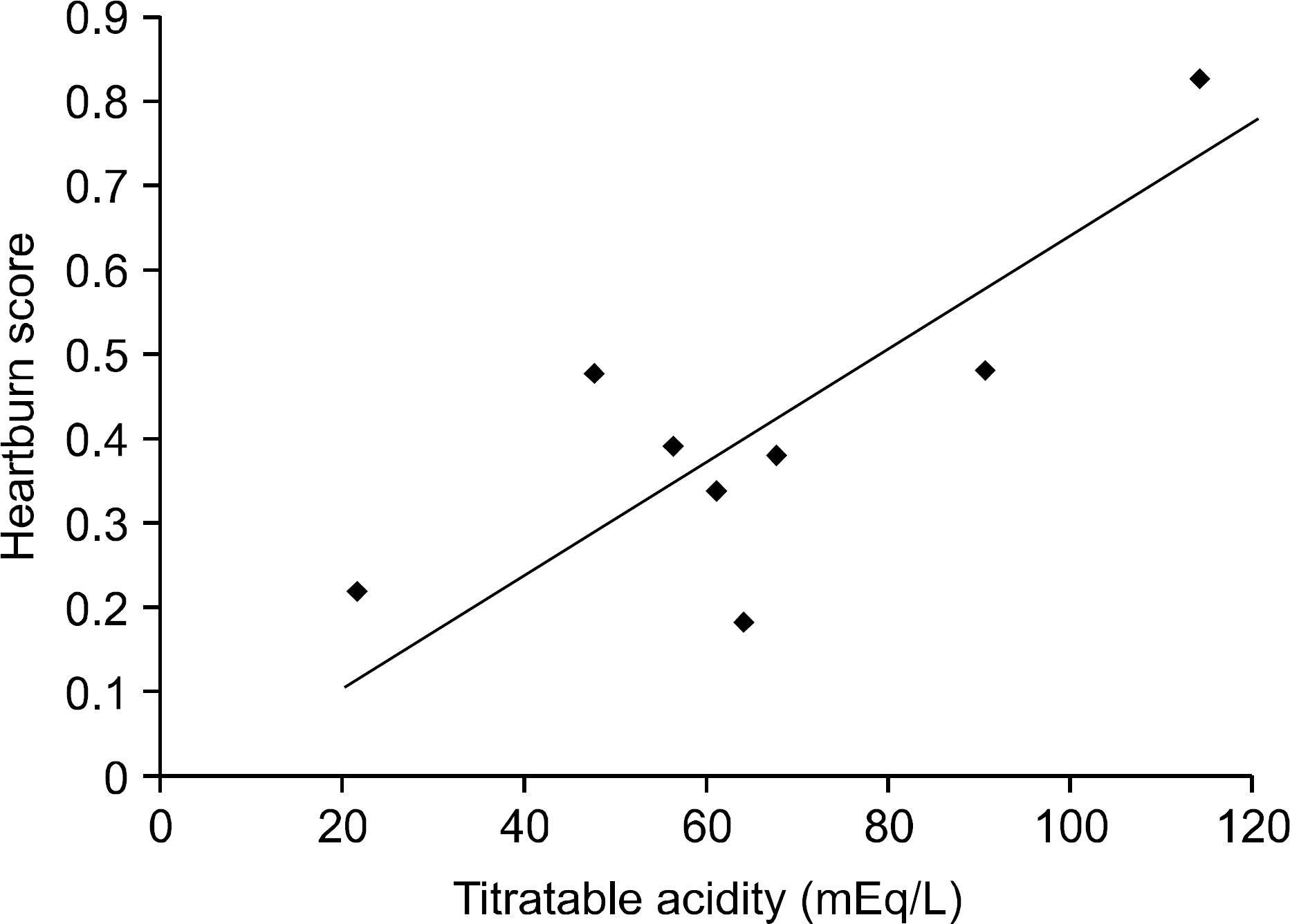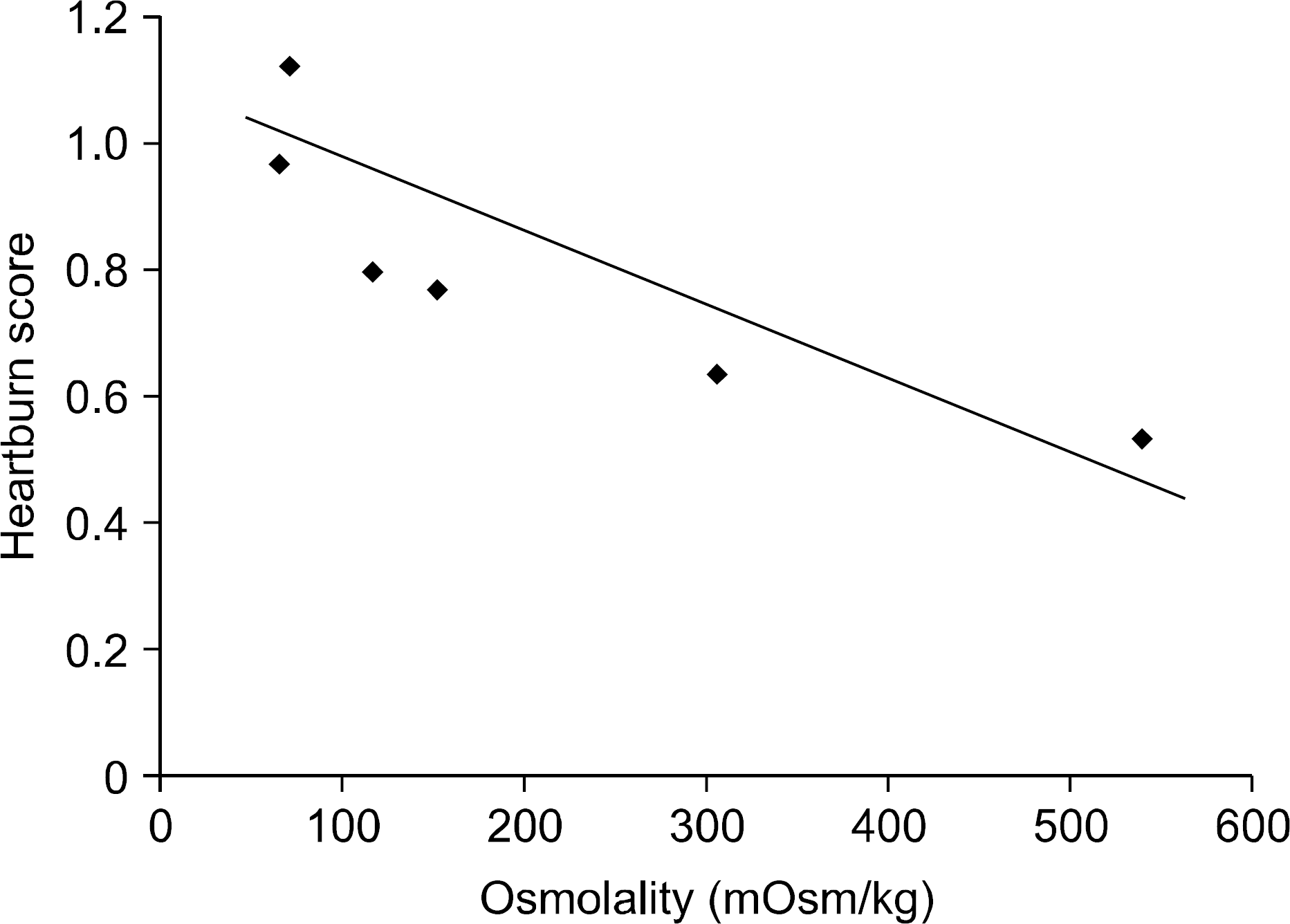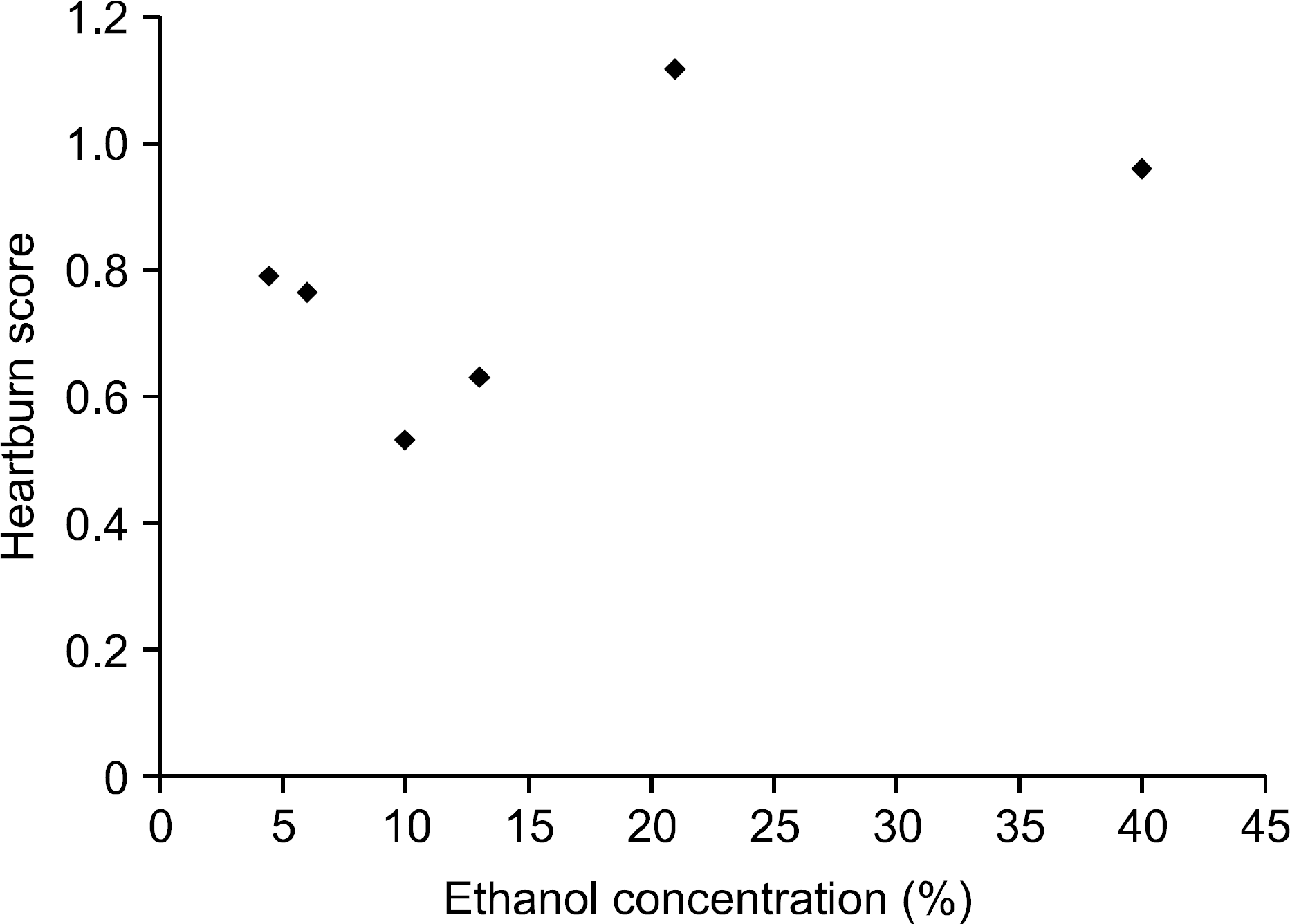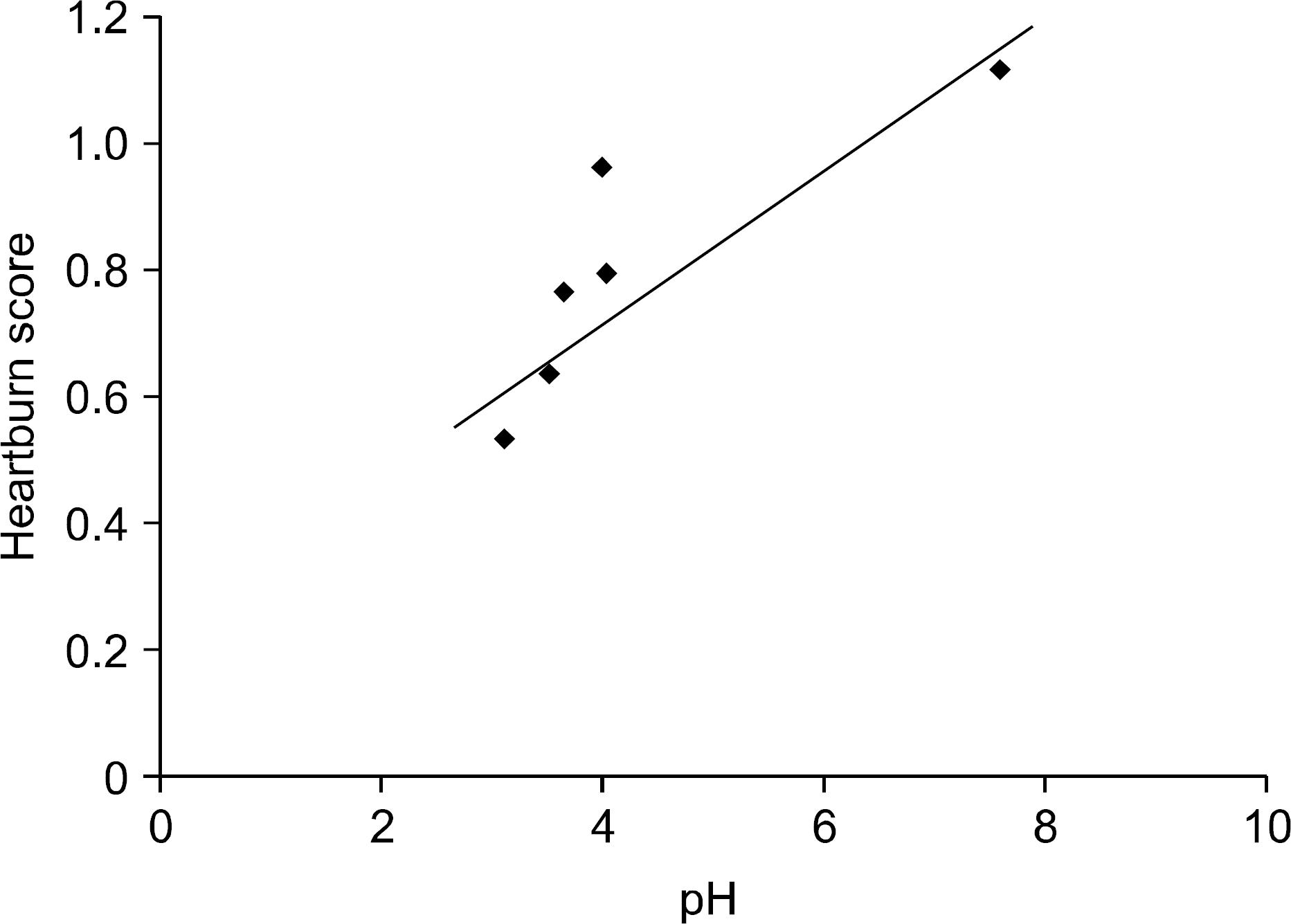Abstract
Background/Aims
The aim of this study was to investigate the frequency of heartburn produced by beverages available in Korea and to clarify the mechanism causing heartburn.
Methods
We measured pH, titratable acidity, and osmolality of 35 beverages in vitro and correlated them with the severity of heartburn reported by questionnaire in 382 patients from November 2004 to June 2005.
Results
Coffee (1.15) and soju (1.12) showed the highest heartburn score, while oolong tea (0.17) and carrot juice (0.18) showed the lowest heartburn score among all beverages. Titratable acidity of citrus juices correlated with heartburn (r=0.78; p=0.023). Soft drinks had the lowest pH, which was unrelated with heartburn scores (r=−0.54; p=0.460). Increasing pH among alcoholic beverages was correlated with heartburn scores (r=0.84; p=0.037), and osmolality was inversely associated with heartburn scores (r=−0.86; p=0.028). The heartburn score of decaffeinated coffee was significantly lower than that of regular coffee (p<0.001). Regular milk caused more heartburn than low-fat milk (p=0.008).
REFERENCES
1. Kim YB, Song CW, Kim HR, et al. The incidence of gastroesophageal reflux disease and the effect of cisapride in patients with epigastric soreness. Korean J Neurogastroenterol Motil. 2000; 6:188–195.
2. Lloyd DA, Borda IT. Food-induced heartburn: effect of osmolality. Gastroenterology. 1981; 80:740–741.

3. Klauser AG, Schindlbeck NE, Mü ller-Lissner SA. Symptoms in gastro-oesophageal reflux disease. Lancet. 1990; 335:205–208.

4. Schiller LR, Walsh JH, Feldman M. Distention-induced gas-trin release: effects of luminal acidification and intravenous atropine. Gastroenterology. 1980; 78:912–917.
5. Cranley JP, Achkar E, Fleshler B. Abnormal lower esophageal sphincter pressure responses in patients with orange juice-induced heartburn. Am J Gastroenterol. 1986; 81:104–106. .6.
6. Decarli A, Liati P, Negri E, Franceschi S, La Vecchia C. Vitamin A and other dietary factors in the etiology of esophageal cancer. Nutr Cancer. 1987; 10:29–37.

7. Ligumsky M, Sestieri M, Okon E, Ginsburg I. Antioxidants inhibit ethanol-induced gastric injury in the rat. Role of man-ganese, glycine, and carotene. Scand J Gastroenterol. 1995; 30:854–860.

8. Feldman M, Barnett C. Relationships between the acidity and osmolality of popular beverages and reported postprandial heartburn. Gastroenterology. 1995; 108:125–131.

9. Cuomo R, Savarese MF, Sarnelli G, et al. Sweetened carbonated drinks do not alter upper digestive tract physiology in healthy subjects. Neurogastroenterol Motil. 2008; 20:780–789.

10. Ibiebele TI, Hughes MC, O'Rourke P, Webb PM, Whiteman DC. Cancers of the esophagus and carbonated beverage consumption: a population-based case-control study. Cancer Causes Control. 2008; 19:577–584.

11. Chari S, Teyssen S, Singer MV. Alcohol and gastric acid secretion in humans. Gut. 1993; 34:843–847.

12. Salaspuro M. Interrelationship between alcohol, smoking, ace-taldehyde and cancer. Norvartis Found Symp. 2007; 285:80–89. discussion 89-96, 198-199.

13. Bujanda L. The effects of alcohol consumption upon the gastrointestinal tract. Am J Gastroenterol. 2000; 95:3374–3382.

14. Woo IS, Kim IH, Yun UJ, et al. An improved method for determination of ethyl carbamate in Korean traditional rice wine. J Ind Microbiol Biotechnol. 2001; 26:363–368.

15. Boekema PJ, Samsom M, van Berge Henegouwen GP, Smout AJPM. Coffee and gastrointestinal function: facts and fiction. A review. Scand J Gastroenterol. 1999; 34(suppl):S35–S39.
16. Pehl C, Pfeiffer A, Wendl B, Kaess H. The effect of de-caffeination of coffee on gastro-oesophageal reflux in patients with reflux disease. Aliment Pharmacol Ther. 1997; 11:483–486.

17. Chow HH, Cai Y, Hakim IA, et al. Pharmacokinetics and safety of green tea polyphenols after multiple-dose admin-istration of epigallocatechin gallate and polyphenon E in healthy individuals. Clin Cancer Res. 2003; 9:3312–3319.
18. McArthur K, Hogan D, Isenberg JI. Relative stimulatory effects of commonly ingested beverages on gastric acid secretion in humans. Gastroenterology. 1982; 83:199–203.

Fig. 1.
Relationship between titratable acidity of citrus juices and heartburn scores (r=0.78; p=0.023).

Fig. 3.
Relationship between osmolality of alcoholic beverages and heartburn scores (r=−0.86; p=0.028).

Fig. 4.
Relationship between ethanol concentration of alcoholic beverages and heartburn scores (p>0.05).

Table 1.
Osmolality, pH, Titratable Acidity, and Heartburn Scores of Beverages Studied
| Beverage (no. of respondents) | pH | Osmolality (mOsm/kg) | Titratable acidity (mEq/L) | Heartburn score (%)∗ |
|---|---|---|---|---|
| Water (108) | 7.19 | 64 | 0 | 0.27 (19.4) |
| Citrus juices | ||||
| Orange juice (Del Monte) (127) | 3.79 | 605 | 114.2 | 0.83† (66.9) |
| Grape juice (Lotte chilsung Co.) (106) | 3.03 | 879 | 67.8 | 0.38‡ (29.2) |
| Tomato juice (Del Monte) (98) | 3.89 | 494 | 61.2 | 0.34‡ (24.5) |
| Apple juice (Ildong foodis Co.) (101) | 3.71 | 681 | 47.9 | 0.48† (38.6) |
| Carrot juice (Lotte chilsung Co.) (89) | 4.16 | 528 | 64.2 | 0.18 (13.5) |
| Japanese apricot juice (Lotte chilsung Co.) (90) | 2.79 | 856 | 56.5 | 0.39‡ (31.1) |
| Pineapple juice (Del Monte) (98) | 3.65 | 698 | 90.7 | 0.48† (39.8) |
| Aloe juice (Lotte chilsung Co.) (83) | 3.34 | 597 | 21.9 | 0.22 (18.1) |
| Soft drinks | ||||
| Pepsi-cola (Pepsico Inc.) (124) | 2.54 | 616 | 40.9 | 0.85† (68.5) |
| Diet coke (Coca-Cola Co.) (84) | 2.87 | 71 | 35.6 | 0.73† (53.6) |
| Chilsung cider (Lotte chilsung Co.) (103) | 2.95 | 572 | 44.3 | 0.67† (53.4) |
| Fanta orange (Coca-Cola Co.) (94) | 2.72 | 810 | 40.1 | 0.60† (45.7) |
| Sports drinks | ||||
| Pocarisweat (Donga-Otsuka Co.) (91) | 3.41 | 305 | 30.4 | 0.24 (17.6) |
| Gatorade (Pepsico Inc.) (85) | 2.96 | 331 | 41.1 | 0.25† (20.0) |
| Coffee, tea and Korean drinks | ||||
| Lets be coffee (Lotte chilsung Co.) (134) | 6.90 | 335 | 0.2 | 1.15† (86.6) |
| Decaffeinated coffee (Dongsuh food Co.) (90) | 6.05 | 265 | 5.7 | 0.87† (62.2) |
| Ceylon tea (Lotte chilsung Co.) (87) | 3.08 | 398 | 14.2 | 0.45‡ (33.3) |
| Green tea (Lotte chilsung Co.) (99) | 6.39 | 69 | 0.5 | 0.44‡ (35.3) |
| Chocolate drink (Hershey foods Co.) (84) | 6.51 | 481 | 4.2 | 0.39‡ (28.6) |
| Fermented rice punch (Lotte chilsung Co.) (102) | 5.79 | 385 | 1.1 | 0.22 (15.7) |
| Sweet cinnamon punch (Korea yakult Co.) (94) | 6.57 | 418 | 0.3 | 0.26 (21.3) |
| Honeyed water (Hoyeondang) (95) | 4.18 | 968 | 2.0 | 0.32‡ (24.2) |
| Oolong tea (Dongsuh food Co.) (78) | 5.61 | 68 | 1.0 | 0.17 (12.8) |
| Bacchus (Dong-a pharm Co.) (92) | 2.71 | 774 | 80.8 | 0.60† (47.8) |
| Alcoholic beverages | ||||
| Beer (Hite Co.) (92) | 4.04 | 118 | 39.1 | 0.79† (60.9) |
| Chamisul soju (Jinro Co.) (117) | 7.62 | 72 | 0 | 1.12† (84.6) |
| Chivas regal (83) | 4.01 | 66 | 2.9 | 0.96† (73.5) |
| Makgeolli, raw rice wine (Sorak yangjo) (85) | 3.66 | 153 | 63.2 | 0.76† (57.6) |
| Refined rice wine (Doosan Co.) (71) | 3.53 | 307 | 30.2 | 0.63† (46.5) |
| Red wine (Jinro Co.) (68) | 3.12 | 541 | 38.6 | 0.53† (42.6) |
| Milks | ||||
| Regular milk (Seoul milk Co.) (107) | 6.58 | 273 | 4.8 | 0.63† (45.8) |
| Low-fat milk (Seoul milk Co.) (92) | 6.63 | 268 | 4.4 | 0.40‡ (29.3) |
| Soybean milk (Samyuk Co.) (93) | 6.29 | 291 | 7.4 | 0.28‡ (23.7) |
| Yogurt (Namyang Co.) (99) | 3.58 | 948 | 66.3 | 0.33‡ (27.3) |
Table 2.
Prevalence of Frequent Heartburn Reported with Beverages Studied
| Beverage (no. of respondents) | No. with frequent heartburn∗ (%)† |
|---|---|
| Water (108) | 8 (7.4) |
| Citrus juices | |
| Orange juice (127) | 20 (15.7) |
| Grape juice (106) | 9 (8.5) |
| Tomato juice (98) | 9 (9.2) |
| Apple juice (101) | 9 (8.9) |
| Carrot juice (89) | 4 (4.5) |
| Japanese apricot juice (90) | 7 (7.8) |
| Pineapple juice (98) | 8 (8.2) |
| Aloe juice (83) | 3 (3.6) |
| Soft drinks | |
| Pepsi-cola (124) | 20 (16.1) |
| Diet coke (84) | 16 (19.0) |
| Chilsung cider (103) | 14 (13.6) |
| Fanta orange (94) | 13 (13.8) |
| Sports drinks | |
| Pocarisweat (91) | 6 (6.6) |
| Gatorade (85) | 4 (4.7) |
| Coffe, tea and Korean drinks | |
| Regular coffee (134) | 38 (28.4) |
| Decaffeinated coffee (90) | 22 (24.4) |
| Ceylon tea (87) | 10 (11.5) |
| Green tea (99) | 9 (9.1) |
| Chocolate drink (84) | 9 (10.7) |
| Fermented rice punch (102) | 6 (5.9) |
| Sweet cinnamon punch (94) | 4 (4.3) |
| Honeyed water (95) | 7 (7.4) |
| Oolong tea (78) | 3 (3.8) |
| Bacchus (92) | 11 (12.0) |
| Alcoholic beverages | |
| Beer (92) | 17 (18.5) |
| Chamisul soju (117) | 32 (27.4) |
| Chivas regal (83) | 19 (22.9) |
| Makgeolli, raw rice wine (85) | 16 (18.8) |
| Refined rice wine (71) | 12 (16.9) |
| Red wine (68) | 7 (10.3) |
| Milks | |
| Regular milk (107) | 18 (16.8) |
| Low-fat milk (92) | 10 (10.9) |
| Soybean milk (93) | 4 (4.3) |
| Yogurt (99) | 6 (6.1) |
Table 3.
Correlation between Ethanol Concentration of Alcoholic Beverages and Heartburn Scores
| Ethanol concentration (%) | Heartburn scores | p-value | |
|---|---|---|---|
| Beer | 4.5 | 0.79 | |
| Chamisul soju | 21 | 1.12 | |
| Chivas regal | 40 | 0.96 | |
| Makgeolli, raw rice wine | 6 | 0.76 | p=0.241 |
| Refined rice wine | 13 | 0.63 | |
| Red wine | 10 | 0.53 |
Table 4.
Correlation between Body Mass Index and Heartburn
| With heartburn | Without heartburn | p-value | |
|---|---|---|---|
| No. of respondents | 190 | 137 | |
| BMI∗, mean (kg/m2) | 22.75 | 26.10 | 0.253 |
Table 5.
Correlation between Smoking and Heartburn∗
| No. with heartburn (%) | No. without heartburn (%) | Total (%) | p-value† | |
|---|---|---|---|---|
| Smoker | 37 (66.1) | 19 (33.9) | 56 (100) | p=0.191 |
| Non-smoker | 106 (59.2) | 73 (40.8) | 179 (100) | |
| Ex-smoker | 45 (51.1) | 43 (48.9) | 88 (100) | |
| Total | 188 (58.2) | 135 (41.8) | 323 (100) |
Table 6.
Difference in Lifestyle of Subjects with or without Heartburn
| Questions | With heartburn∗ (n=224) | Without heartburn∗ (n=150) | p-value |
|---|---|---|---|
| How often do you | <0.0001 | ||
| experience heartburn? | |||
| Daily | 19 | 4 | |
| 2-5 times a week | 39 | 7 | |
| Once a week | 32 | 4 | |
| 1-2 times a month | 39 | 13 | |
| Less than once a month | 34 | 35 | |
| Do you experience | 0.0053 | ||
| heartburn after overeating? | |||
| Always | 18 | 2 | |
| Sometimes | 105 | 33 | |
| Never | 59 | 37 | |
| Do not overeat | 8 | 8 | |
| Do you have a | 0.0054 | ||
| midnight snack? | |||
| Daily | 15 | 11 | |
| 2-5 times a week | 42 | 26 | |
| Once a week | 54 | 11 | |
| 1-2 times a month | 23 | 8 | |
| Less than once a month | 12 | 15 | |
| Never | 48 | 22 | |
| When do you go to bed | 0.8533 | ||
| after midnight snack? | |||
| Immediately after | 10 | 5 | |
| 30 minutes later | 34 | 12 | |
| 1 hour later | 72 | 32 | |
| 2 hours later | 32 | 18 | |
| Over 3 hours later | 9 | 3 |




 PDF
PDF ePub
ePub Citation
Citation Print
Print



 XML Download
XML Download